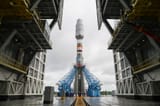Search Results
7/23/2025, 4:02:53 AM
A soyuz-2.1b is on the pad in the Vostochny Cosmodrome ahead of a launch on Friday, it will mainly send the Ionosfera-M 3/4 satellites to 800km orbit, they will join the 1/2 satellites launched last november and together monitor the earth’s ionosphere and improve our understanding of geomagnetic and solar storms, and their impact on the Earth.
>The ionosphere is a section of the Earth’s upper atmosphere that ranges approximately 85 km to 600 km above Earth’s surface. In this layer of the atmosphere, Extreme Ultraviolet (EUV) and X-ray solar radiation ionise the particles and generate a layer of free electrons.The ionosphere is highly variable, as particles undergo photoionisation when exposed to the sun, and return to a neutral state when shielded by the Earth. Additionally, the degree of ionisation in the ionosphere varies based on solar activity, as periods associated with increased sunspot activity will lead to an increase in coronal heating and EUV/X-ray radiation, increasing ionisation and causing the ionosphere to expand. This variability in ionisation can impact satellites orbiting in the ionosphere, as sudden swells of charged particles from the expanding atmosphere increase drag, impacting the orbit lifetime of satellites. Furthermore, ionosphere fluctuations can result in disturbances to radio signals, which are reflected off the ionosphere, and GPS signals which pass through it. Ionosphera-M will conduct a study of this region by deploying instruments that measure basic plasma parameters, the concentration, temperature and direction of particles, as well as the characteristics of electromagnetic fields and waves
Additionaly, 18 small satellites will also be launched, 17 russians one,mainly 9 earth observation satellite by the Geoscan company, and one Iranian satellite: the Nahid-2 communication technological demonstrator satellite.
>The ionosphere is a section of the Earth’s upper atmosphere that ranges approximately 85 km to 600 km above Earth’s surface. In this layer of the atmosphere, Extreme Ultraviolet (EUV) and X-ray solar radiation ionise the particles and generate a layer of free electrons.The ionosphere is highly variable, as particles undergo photoionisation when exposed to the sun, and return to a neutral state when shielded by the Earth. Additionally, the degree of ionisation in the ionosphere varies based on solar activity, as periods associated with increased sunspot activity will lead to an increase in coronal heating and EUV/X-ray radiation, increasing ionisation and causing the ionosphere to expand. This variability in ionisation can impact satellites orbiting in the ionosphere, as sudden swells of charged particles from the expanding atmosphere increase drag, impacting the orbit lifetime of satellites. Furthermore, ionosphere fluctuations can result in disturbances to radio signals, which are reflected off the ionosphere, and GPS signals which pass through it. Ionosphera-M will conduct a study of this region by deploying instruments that measure basic plasma parameters, the concentration, temperature and direction of particles, as well as the characteristics of electromagnetic fields and waves
Additionaly, 18 small satellites will also be launched, 17 russians one,mainly 9 earth observation satellite by the Geoscan company, and one Iranian satellite: the Nahid-2 communication technological demonstrator satellite.
Page 1
